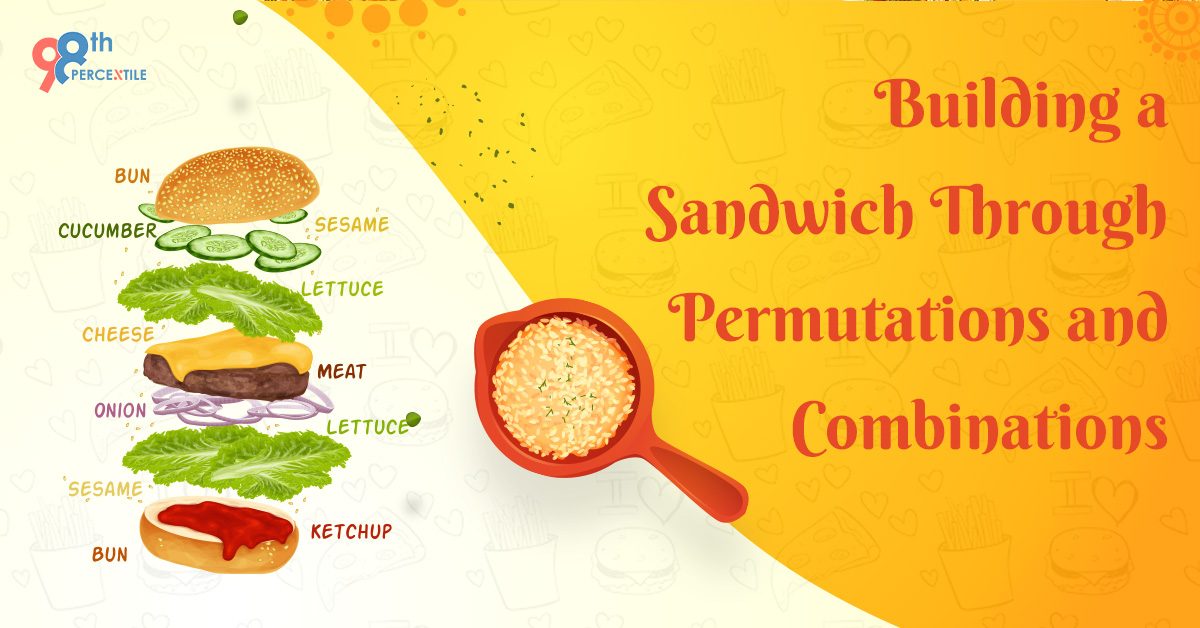Making a sandwich may appear to be a simple endeavor, but as you get into the realm of permutations and combinations, you'll realize that creating the ideal sandwich is more than simply a culinary marvel; it's a mathematical journey.
Download FREE Math Worksheets!
Exploring Permutations: Bread Selection
Let us start with permutations. Assume you're standing in front of a display of six different varieties of bread. In mathematical terms, you have six possibilities and wish to choose only one for your sandwich. This is a simple illustration of a permutation.
In permutations, order matters. When you choose a specific sort of bread, you create a unique sequence. For example, choosing white bread (W) differs from picking whole wheat bread. The possibilities for picking one variety of bread from six options can be expressed as:
6P1 = 6
The result, 6, signifies the six possible ways to choose one type of bread from the options available. It might sound simple, but it's an essential concept in combinatorics.
Discovering Combinations: Filling your Sandwich
Let's now move on to combinations, a notion that is unconcerned about the sequence of your selections and concentrates purely on what you choose. Assume you have 10 different fillings to pick from and want to use three of them on your sandwich. How many different combinations can you make?
To compute this, we apply the combination formula:
C(n, k) = n! / (k! * (n - k)!)
Where:
· n is the total number of options (10 fillings).
· k is the number of choices (3 fillings).
· ! denotes factorial.
Connecting the Ethics
C(10, 3) = 10! / (3! * (10 - 3)!) C(10, 3) = 120
There are 120 different combinations of 3 fillings you can create for your sandwich. Combinations are incredibly useful for scenarios where the order doesn't matter, like selecting toppings for a pizza or, in our case, assembling a sandwich.
Adding Fillings: A Pinch of Complexity
Toppings are where the complexity of permutations and combinations truly shines. Suppose you have eight delicious toppings to choose from, and you want to add two to your sandwich. Using the combination formula:
C(8, 2) = 8! / (2! * (8 - 2)!) C(8, 2) = 28
There are 28 different combinations of 2 toppings that can adorn your sandwich. Combinations, in this context, allow you to explore various flavor profiles by choosing different combinations of toppings.
The Ultimate Total: Creating Your Distinctive Sandwich
So, when you stand in front of the deli counter, with six bread alternatives, 120 filling permutations, and 28 topping variants, you may comprehend the vast mathematical possibilities that await you. Every decision you make, whether it's the bread, fillings, or toppings, contributes to a distinct flavor experience.
Let’s check some examples
Problem 1: Seating structure
You are hosting a dinner party with five friends, and you have a circular dining table that seats six people. In how many ways can you arrange the seating for yourself and your friends?
Solution 1
This problem involves circular permutations because the seating arrangement is around a circular table. To calculate the number of ways to arrange the seating, you can use the formula for circular permutations:
A number of ways = (n - 1)!
Where n is the number of people, which is 6 in this case.
A number of ways = (6 - 1)!
A number of ways = 5!
Number of ways = 5 × 4 × 3 × 2 × 1
Number of ways = 120 ways
So, there are 120 different ways to arrange the seating for yourself and your friends at the circular dining table.
Problem 2: Forming a Committee
In a club, there are 10 members, and you need to select a committee of 3 members. How many different committees can you form?
Solution 2
This problem involves combinations because you are selecting a committee without considering the order. You can use the combination formula:
Number of ways = C(n, k)
Where n is the total number of members (10) and k is the number of members to be selected (3).
Number of ways = C(10, 3)
Applying the Combination Equation:
A number of ways = 10! / (3! * (10 - 3)!) Number of ways = (10 × 9 × 8) / (3 × 2 × 1) Number of ways = 120 ways
So, there are 120 different committees you can form by selecting 3 members from a group of 10.
Problem 3: Placing books on a shelf
You have 7 different books, and you want to arrange them on a shelf. How many different ways can you arrange the books if the order matters?
Solution 3
This problem involves permutations because the order of the books on the shelf matters. To calculate the number of ways to arrange the books, you can use the permutation formula:
Number of ways = P(n, k)
Where n is the total number of books (7) and k is the number of books to be arranged (7, as you're arranging all of them).
Number of ways = P(7, 7)
Applying the permutation formula:
A number of ways = 7!
Number of ways = 7 × 6 × 5 × 4 × 3 × 2 × 1 Number of ways = 5,040 ways
So, there are 5,040 different ways to arrange the 7 books on the shelf, considering the order in which they are placed.
Permutations and combinations are more than simply mathematical notions; they are tools for creating the ideal sandwich, suited to your taste senses' preferences. Whether you're a foodie or a math aficionado, this enjoyable voyage into the realm of permutations and combinations exposes the subtle and creative side of mathematics that can be found in the most unexpected places—even in your regular luncheon choices. Enjoy your delightful exploration!
Book FREE Math Trial Classes Now!

 Students/Staff
Students/Staff Parents
Parents ElevatEd
ElevatEd














